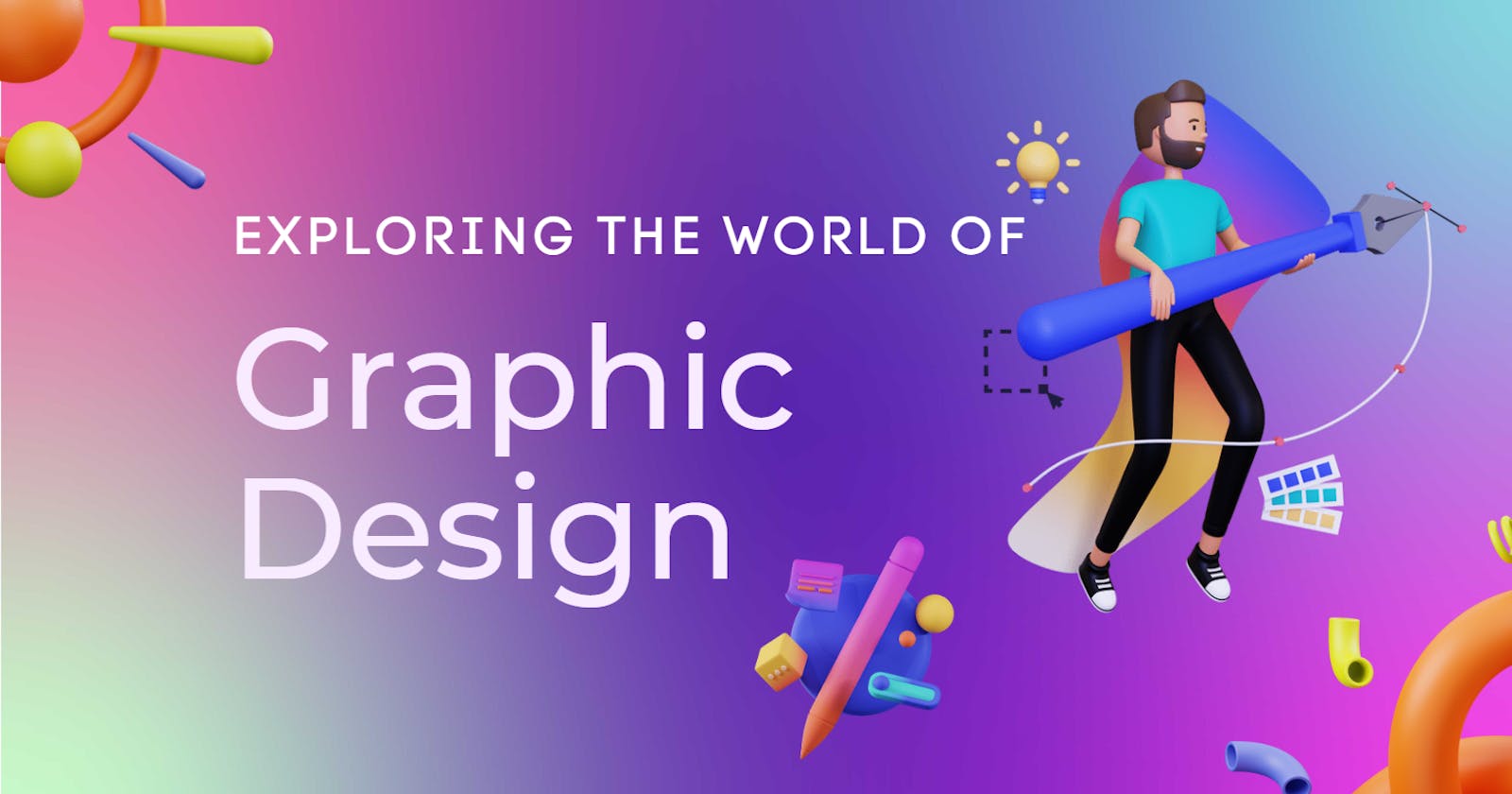Exploring the World of Graphic Design: Tips, Trends, and Insights for Creatives
Dive into the vibrant world of graphic design with expert tips, latest trends, and insightful insights for designers
Table of contents
Introduction:
Graphic design is an incredibly important field that plays a role in nearly every aspect of our lives. From the packaging on the products, we buy to the signs we see in public, to the websites we visit and the apps we use on our phones, graphic design is everywhere.
Graphic design is more than just making things look pretty – it’s a way to communicate ideas and information visually. Good graphic design is effective, engaging, and can even be transformative.
If you’re a graphic designer or are thinking about pursuing a career in the field, there are a few key things you should know.
First and foremost, it’s important to have a strong foundation in the principles of design. This includes things like color theory, typography, composition, and hierarchy. These principles will guide your decisions and help ensure that your designs are effective and impactful.

In addition to having a strong foundation in design principles, it’s also important to stay up-to-date with the latest trends and technology in the field. This means staying on top of the latest design software, as well as keeping an eye on what other designers are doing. This will not only help you to create better designs, but it will also help you to stay competitive in the job market.
Another important aspect of being a graphic designer is the ability to work with clients. This means being able to understand their needs and goals, and translating them into visual solutions. It also means being able to communicate your ideas and designs to clients, and being open to feedback and revisions.
Overall, being a graphic designer is a challenging and rewarding career. It requires creativity, technical skills, and the ability to problem-solve and think outside the box. If you’re passionate about design communication, it could be the perfect field for you. And have a knack for visual
Trends:

Geometric Shapes and Patterns:
Geometric shapes and patterns are often used in graphic design to create interesting and eye-catching visuals. Common geometric shapes used in graphic design include squares, circles, triangles, and rectangles. Patterns can be created with these shapes, as well as with lines, dots, and other shapes. Geometric shapes and patterns can be used to create balance, unity, and direction in a design, as well as to create a sense of movement and rhythm. They can be used to create a sense of harmony and order, or to create a sense of complexity and chaos. Geometric shapes and patterns can also be used to create a focal point or to add depth and dimension to a design.
Retro and Vintage Design:
It is a style of graphic design that evokes feelings of nostalgia and reminiscence of bygone eras. This style of design is often characterized by vibrant colors, bold typefaces, and a mix of various design elements from different time periods. Retro and vintage designs often include a blend of classic and modern ideas, creating a unique and timeless design aesthetic. This style of design is often used in branding, packaging, advertising, and other forms of visual communication.
Hand-Drawn Illustrations:
These can be used in graphic design to add a personal touch and evoke a certain emotion that can help to bring a message to life. While this style of illustration is often used for children’s books or cartoon-like designs, it can also be used to create a more sophisticated and mature look in certain types of graphic design. Hand-drawn illustrations can be used to create logos, posters, book covers, and even website designs. They can be used to create a unique and personalized look to a design, as well as to add a special touch of creativity.
Minimalism:
Minimalism in graphic design is a style that uses an extremely simple and clean visual aesthetic, often with limited colors and minimal use of images and text. This style is often used to convey a message or create a certain atmosphere without overloading the viewer with too much information. It is also used to create a sense of focus or to make a design stand out from its competitors.
Bold Typography:
Bold typography is a powerful and versatile tool for graphic designers. It can be used to create an impactful statement and draw attention to important information. Bold typography can also be used to create a sense of hierarchy and structure within a design, making it easier for the user to understand and navigate the design. Additionally, bold typography can add a sense of personality and emotion to a design, making it stand out from other designs.
Color Blocking:
Color blocking is a popular graphic design technique used to create visual interest and contrast within a design. It involves the use of two or more solid, contrasting colors, usually in large blocks of color. This technique can be used to create a striking, abstract look or to create a more subtle and harmonious design. When used in combination with other design elements such as typography, shapes, and textures, color blocking can be used to create dynamic and eye-catching visuals.
Isometric Illustrations:
Isometric illustrations are graphic design illustrations that depict three-dimensional objects in two dimensions. They are often used to add visual interest and detail to a design. Isometric illustrations can illustrate complex systems or products, showcase products uniquely, or add a playful or retro feel to a design. Isometric illustrations can be simple, like a cube, or complex, like a building or a machine. They are often used in the fields of architecture, engineering, and science.
Gradients:
Gradients can be used to create a variety of effects in graphic design, from subtle transitions between colors to a vibrant and dynamic look. In most cases, a gradient is created by blending two or more colors together. This is done by gradually changing the color of one color to another, usually over a defined area. This can be done to create an ombre effect, a shadow effect, or simply to add a more vibrant feel to a design. Gradients can be used to help draw the eye to an area of the design, or to create a sense of depth and movement. Additionally, gradients can be used to create an interesting background or to provide a subtle texture to a design.
Duotone:
Duotone is a term used in graphic design to describe a two-color halftone reproduction of an image (usually in black and a single spot color). Duotones are commonly used in print media, especially magazines, to add visual interest and contrast to images. They can be used to make images appear more vibrant and to create a sense of depth. Duotones can also be used to create a vintage or retro feel. Duotones are created by applying a halftone dot pattern to a black-and-white image and then separating it into two plates. The first plate contains the black image, and the second plate is then printed with a spot color, such as a Pantone or CMYK value. The halftone dot pattern creates a smooth gradation between the two colors, which adds a heightened level of contrast and detail to the image. Duotones are often used in combination with other printing techniques such as embossing, foil stamping, and varnish to create a more dynamic and intricate design. Duotone images can also be used as a starting point for other design projects, such as creating a color palette or generating textures and patterns.
Custom Shapes and Icons:
Custom shapes and icons can be used in graphic design to add visual interest and focus to a design. They can also be used to create a memorable logo or brand identity or to convey a message that words cannot express. Custom shapes and icons can be created in a variety of ways, including hand drawing, vector drawing, or using a photo-editing program. Iconography is an important part of graphic design, as it can be used to quickly and effectively communicate a message or idea to viewers.
Tips:

Keep up with the latest design trends and technology:
This will help you stay current and ensure that your designs are modern and relevant.
Learn to use design software:
Such as Adobe Photoshop, Illustrator, and InDesign. These are industry-standard tools that are essential for any graphic designer
Stay organized:
Graphic design projects can be complex and involve a lot of moving parts. Staying organized will help you manage your time and keep your projects on track.
Be flexible:
In the world of design, things can change quickly. Be prepared to adapt to new information and feedback, and be willing to make changes to your designs as needed.
Take care of yourself:
Design work can be demanding and stressful, so it's important to take care of yourself physically and mentally. Make sure to get enough sleep, exercise, and take breaks when you need them.
Insights in Graphic Designers:

Stay up-to-date with the latest trends:
Keeping up with the latest trends in the graphic design industry is important for staying competitive. Monitor industry blogs, magazines, and websites to get a sense of what the industry is doing and how you can use it to your advantage.
Invest in quality tools:
Investing in quality tools such as software, fonts, and stock images will help you create higher-quality designs and make your work stand out from the crowd.
Develop a unique style:
Developing and maintaining a unique style will help you stand out from the competition and provide potential clients with a sense of your skill set.
Network and collaborate:
Networking with other professionals, joining LinkedIn groups, and attending events are great ways to build relationships, gain exposure, and get inspired by other designers
Keep learning:
Never stop learning. Graphic design is constantly changing, so it is important to stay up-to-date with the latest techniques, technologies, and trends.

